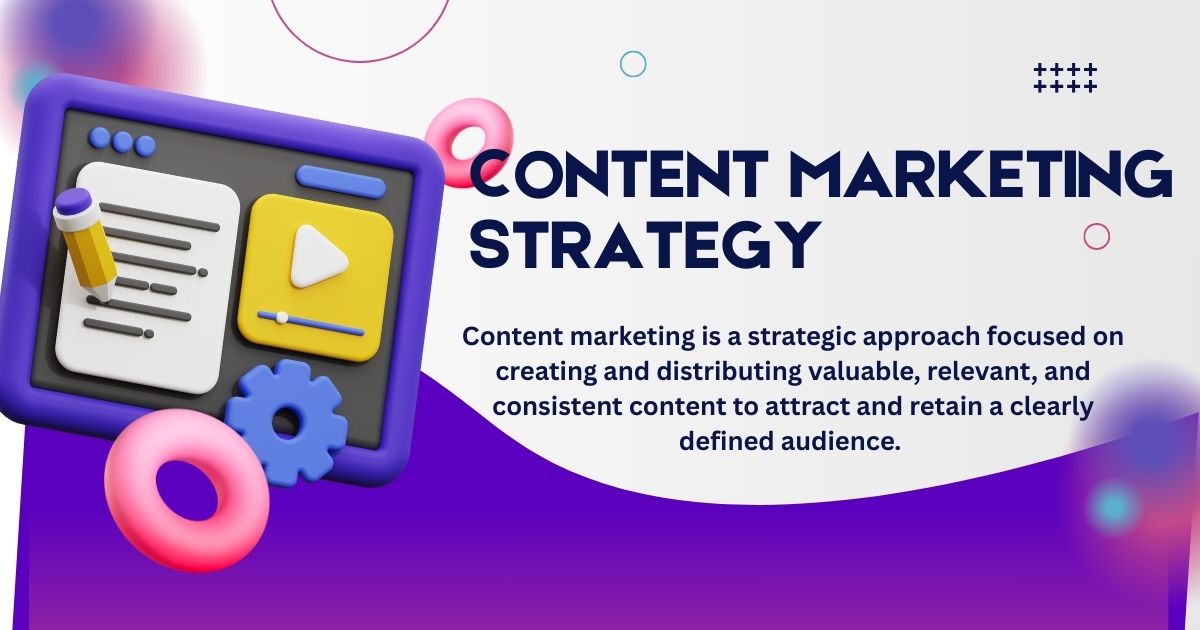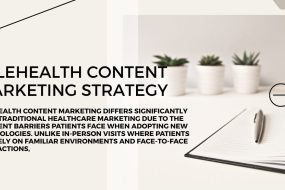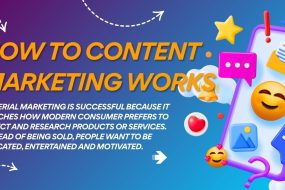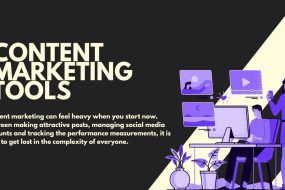
Material marketing has become one of the most powerful strategies for marketing companies to contact the public, build self -confidence and increase development. Nevertheless, many business owners and abstractions are still struggling to understand what it really means and how they can implement it effectively.
This broad guide will break everything needed to learn about material marketing – from the main definition to practical implementation strategies. Whether you are new to marketing or want to refine your approach, you will know how to make content resonant with the audience and produce average results.
Understanding Content Marketing
Content marketing is a strategic approach focused on creating and distributing valuable, relevant, and consistent content to attract and retain a clearly defined audience. The ultimate goal is to drive profitable customer action.
Unlike traditional advertising that interrupts consumers with promotional messages, content marketing provides genuine value first. It educates, entertains, or solves problems for your audience before asking for anything in return.
The Core Philosophy
The foundation of content marketing rests on a simple principle: help your audience succeed, and they’ll help your business succeed. This customer-centric approach builds relationships rather than just pushing products.
Content optimization recognizes that modern consumers are bombarded with advertising messages daily. They’ve developed sophisticated filters to ignore promotional content that doesn’t serve their interests. By providing valuable information, businesses can earn attention rather than demanding it.
How Content Marketing Works

Content marketing works through a cycle of creation, distribution, and optimization. Here’s how the process typically unfolds:
The Content Creation Process
First, you identify your audience’s needs, challenges, and interests. This research forms the foundation for all content decisions. You then create materials that address these specific pain points or interests.
Content can take many forms—blog posts, videos, podcasts, infographics, social media posts, or email newsletters. Content Marketing matters less than the value it provides to your audience.
Distribution and Amplification
Creating great content optimization is only half the battle. You must also ensure it reaches your intended audience through appropriate channels. This might include your website, social media platforms, email lists, or third-party publications.
Effective distribution often involves repurposing content across multiple channels. A single blog post might become a series of social media posts, an email newsletter segment, and a podcast episode.
Measurement and Optimization
Successful content marketing requires ongoing measurement and refinement. You track metrics like engagement rates, website traffic, lead generation, and conversion rates to understand what resonates with your audience.
This data informs future content decisions, helping you focus on topics and formats that deliver the best results.
Learn about How to Promote Telehealth Services
Types of Content Marketing
Content marketing encompasses a wide range of formats and approaches. Understanding these options helps you choose the right mix for your audience and goals.
Educational Content
Educational content positions your brand as a trusted resource by teaching your audience valuable skills or knowledge. This includes how-to guides, tutorials, case studies, and industry insights.
Educational content works particularly well for complex products or services that require explanation. It helps potential customers understand your offerings while building confidence in your expertise.
Entertainment Content
Entertainment content captures attention through humor, storytelling, or compelling visuals. While it may not directly relate to your products, it builds brand awareness and emotional connections.
This approach works well for brands targeting younger demographics or industries where personality and culture play important roles in purchasing decisions.
Inspirational Content
Inspirational content motivates your audience through success stories, behind-the-scenes glimpses, or aspirational messaging. It helps create emotional bonds between your brand and customers.
This type of content often performs well on social media platforms where sharing and engagement are prioritized.
Problem-Solving Content
Problem-solving content directly addresses specific challenges your audience faces. It demonstrates your understanding of their needs while showcasing your ability to provide solutions.
This approach often generates high-quality leads because it attracts people actively seeking solutions to problems your business can solve.
Read which strategy wins? Content Marketing vs Traditional Marketing
Benefits of Content Marketing
Content marketing offers numerous advantages over traditional advertising methods. These benefits compound over time, making it an increasingly valuable investment.
Cost-Effectiveness
Content marketing typically costs less than traditional advertising while delivering better long-term results. A well-optimized blog post can continue attracting visitors and generating leads for months or years after publication.
While creating quality content requires time and effort, it doesn’t require the ongoing media spend associated with paid advertising campaigns.
Builds Authority and Trust
Content establishes your brand as an industry authority. This credibility becomes increasingly important as consumers research purchases more thoroughly before buying.
Trust-building through content marketing creates a competitive advantage that’s difficult for competitors to replicate quickly.
Improves Search Engine Visibility
Search engines reward websites that regularly publish high-quality, relevant content. This improved visibility can drive significant organic traffic to your website.
Content marketing and search engine optimization work together synergistically. Fresh content provides opportunities to target new keywords and topics relevant to your audience.
Supports the Entire Customer Journey
Content marketing can guide prospects through every stage of the buying process. Awareness-stage content introduces your brand to new audiences. Consideration-stage content helps evaluate options. Decision-stage content addresses final concerns and objections.
This comprehensive approach ensures you’re supporting potential customers regardless of where they are in their journey.
Creating Your Content Marketing Strategy

Developing an effective content marketing strategy requires careful planning and clear objectives. Here’s how to build a foundation for success.
Define Your Goals
Start by establishing specific, measurable goals for your content marketing efforts. These might include increasing website traffic, generating qualified leads, improving brand awareness, or nurturing existing customers.
Clear goals help guide content creation decisions and provide benchmarks for measuring success.
Know Your Audience
Deep audience understanding is crucial for content marketing success. Develop detailed buyer personas that include demographics, interests, challenges, and preferred communication styles.
This information helps you create content that resonates with your target audience and choose appropriate distribution channels.
Choose Your Content Types
Select content formats that align with your audience preferences and business capabilities. Consider your team’s skills, available resources, and distribution channels when making these decisions.
Starting with one or two content types and expanding over time often works better than trying to do everything at once.
Develop a Content Calendar
A content calendar helps ensure consistent publishing and strategic alignment. Plan content themes, topics, and publication dates in advance.
This planning also helps you coordinate content with mobile marketing activities, product launches, or seasonal trends.
Common Content Marketing Mistakes to Avoid
Many businesses struggle with content marketing because they fall into predictable traps. Avoiding these mistakes can significantly improve your results.
Focusing on Quantity Over Quality
Publishing frequent, low-quality content often performs worse than less frequent, high-quality content. Your audience will quickly lose interest if your content doesn’t provide genuine value.
Focus on creating fewer pieces of exceptional content rather than rushing to fill a publishing schedule.
Neglecting Distribution
Many businesses invest heavily in content creation but give little thought to distribution. Even the best content won’t succeed if it doesn’t reach your intended audience.
Develop a systematic approach to sharing and promoting your content across relevant channels.
Ignoring Performance Data
Content marketing success requires ongoing optimization based on performance data. Businesses that don’t track and analyze their results miss opportunities to improve.
Regularly review your content performance and adjust your strategy based on what the data tells you.
Measuring Content Marketing Success

Effective measurement helps you understand what’s working and where to focus future efforts. Different types of content and goals require different metrics.
Traffic Metrics
Website traffic metrics show how effectively your content attracts visitors. Look at both total traffic and traffic from specific sources to understand which distribution channels work best.
Pay attention to new versus returning visitors to gauge how well your content attracts new audiences while retaining existing ones.
Engagement Metrics
Engagement metrics reveal how your audience interacts with your content. Time on page, social shares, comments, and click-through rates all indicate content resonance.
High engagement often correlates with better search engine rankings and increased brand loyalty.
Lead Generation Metrics
For businesses focused on lead generation, track how your content contributes to filling your sales pipeline. This includes form submissions, email sign-ups, and content downloads.
Understanding which content pieces generate the most qualified leads helps inform future content creation priorities.
Conversion Metrics
Ultimately, content marketing should contribute to business growth. Track how content influences actual sales, whether through direct attribution or assisted conversions.
This data helps justify content marketing investments and identify opportunities for improvement.
Getting Started with Content Marketing
Material marketing success is not overnight, but you can start building speed with these practical first stages.
Start by revising your existing material to understand what you already have and how it is performing. This base line helps identify intervals and opportunities for improvement.
Then select a material type that matches the audience’s preferences and team skills. Master in this format before the expansion of others.
Make a simple material calendar for the next three months. When building the muscle for content marketing, you must take into account stability instead of volume.
Finally, install a system to measure and analyze the results. Regular reviews and adjustments will accelerate your progress and help you avoid normal losses.-
Building Long-Term Success
Material marketing is a long -term strategy that produces value over time. Successful businesses are those who are committed to consistently provide value to the public, even when immediate results are not clear.
Be aware of making materials that actually help the audience succeed. This customer -centered approach will eventually run the business results you want when you create a permanent relationship with your customers.
Remember that material marketing is both an art and a science. Although data and strategy are important, the most successful material often comes from the audience’s understanding at the human level and meets their actual needs with real sympathy and competence.


















No Comments